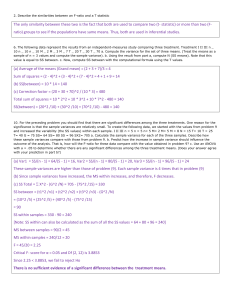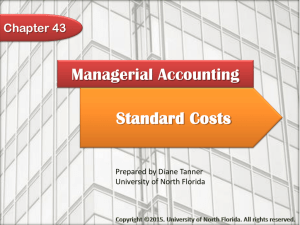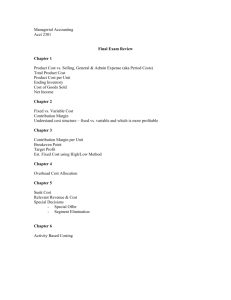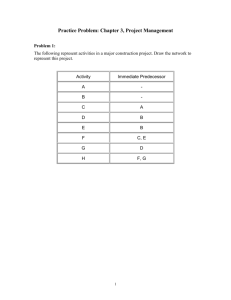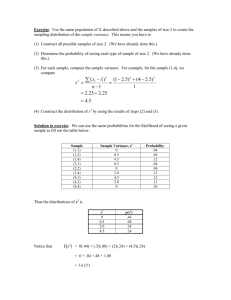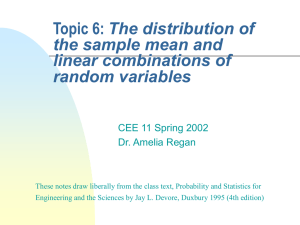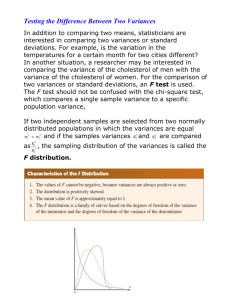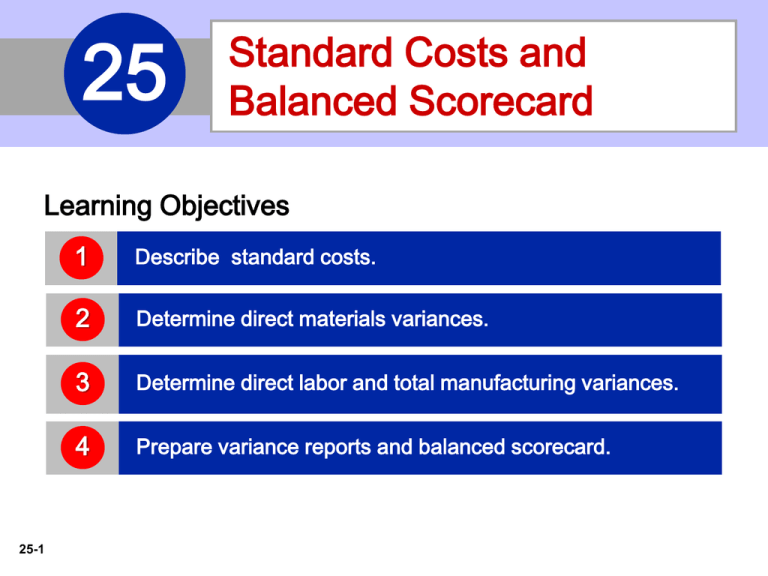
25
Standard Costs and
Balanced Scorecard
Learning Objectives
25-1
1
Describe standard costs.
2
Determine direct materials variances.
3
Determine direct labor and total manufacturing variances.
4
Prepare variance reports and balanced scorecard.
LEARNING
OBJECTIVE
1
Describe standard costs.
Distinguishing Between Standards and Budgets
Both standards and budgets are predetermined costs, and
both contribute to management planning and control.
There is a difference:
25-2
A standard is a unit amount.
A budget is a total amount.
LO 1
Advantages
Illustration 25-1
25-3
LO 1
Setting Standard Costs
Setting standard costs requires input from all persons who
have responsibility for costs and quantities.
Standards should change whenever managers determine
that the existing standard is not a good measure of
performance.
25-4
LO 1
Setting Standard Costs
IDEAL VERSUS NORMAL STANDARDS
Companies set standards at one of two levels:
Ideal standards represent optimum levels of performance
under perfect operating conditions.
Normal standards represent efficient levels of performance
that are attainable under expected operating conditions.
Properly set, normal standards
should be rigorous but attainable.
25-5
LO 1
Setting Standard Costs
Question
Most companies that use standards set them at a(n):
a. optimum level.
b. ideal level.
c. normal level.
d. practical level.
25-6
LO 1
Accounting Across the Organization
Navy
How Do Standards Help a Business?
A number of organizations, including corporations, consultants,
and governmental agencies, share information regarding
performance standards in an effort to create a standard set of
measures for thousands of business processes. The group,
referred to as the Open Standards Benchmarking Collaborative,
includes IBM, Procter and Gamble, the U.S. Navy, and the World
Bank. Companies that are interested in participating can go to the
group’s website and enter their information.
Source: Becky Partida, “Benchmark Your Manufacturing Performance,”
Control Engineering (February 4, 2013).
25-7
LO 1
Setting Standard Costs
A CASE STUDY
To establish the standard cost of producing a product, it is
necessary to establish standards for each manufacturing cost
element—
direct materials,
direct labor, and
manufacturing overhead.
The standard for each element is derived from the standard
price to be paid and the standard quantity to be used.
25-8
LO 1
Setting Standard Costs
DIRECT MATERIALS
The direct materials price standard is the cost per unit of
direct materials that should be incurred.
Illustration 25-2
Setting direct materials price standard
25-9
LO 1
Setting Standard Costs
DIRECT MATERIALS
The direct materials quantity standard is the quantity of direct
materials that should be used per unit of finished goods.
Illustration 25-3
Setting direct materials
quantity standard
25-10
Standard direct materials cost is $12.00
($3.00 x 4.0 pounds).
LO 1
Setting Standard Costs
Question
The direct materials price standard should include an
amount for all of the following except:
a. receiving costs.
b. storing costs.
c. handling costs.
d. normal spoilage costs.
25-11
LO 1
Setting Standard Costs
DIRECT LABOR
The direct labor price standard is the rate per hour that should
be incurred for direct labor.
Illustration 25-4
Setting direct labor price standard
25-12
LO 1
Setting Standard Costs
DIRECT LABOR
The direct labor quantity standard is the time that should be
required to make one unit of the product.
Illustration 25-5
Setting direct labor
quantity standard
25-13
The standard direct labor cost is
$30 ($15.00 x 2.0 hours).
LO 1
Setting Standard Costs
MANUFACTURING OVERHEAD
For manufacturing overhead, companies use a standard
predetermined overhead rate in setting the standard.
This overhead rate is determined
by dividing budgeted overhead
costs by an expected standard
activity index, such as standard
direct labor hours or standard
machine hours.
25-14
LO 1
Setting Standard Costs
MANUFACTURING OVERHEAD
The company expects to produce 13,200 gallons during the
year at normal capacity. It takes 2 direct labor hours for each
gallon.
Illustration 25-6
Computing predetermined
overhead rates
25-15
Standard manufacturing overhead rate
per gallon is $10 ($5 x 2 hours).
LO 1
Setting Standard Costs
TOTAL STANDARD COST PER UNIT
The total standard cost per unit is the sum of the standard costs
of direct materials, direct labor, and manufacturing overhead.
Illustration 25-7
Standard cost per gallon
of Xonic Tonic
25-16
The total standard cost per gallon
LO 1
DO IT! 1
Standard Costs
Ridette Inc. accumulated the following standard cost data concerning
product Cty31.
Materials per unit: 1.5 pounds at $4 per pound.
Labor per unit: 0.25 hours at $13 per hour.
Manufacturing overhead: Predetermined rate is 120% of direct labor cost.
Compute the standard cost of one unit of product Cty31.
25-17
LO 1
LEARNING
OBJECTIVE
2
Determine direct materials variances.
Analyzing and Reporting Variances
Variances are the differences between total actual costs and
total standard costs.
Actual costs < Standard costs = Favorable variance.
Actual costs > Standard costs = Unfavorable variance.
Variance must be analyzed to determine the underlying
factors.
Analyzing variances begins by determining the cost elements
that comprise the variance.
25-18
LO 2
Analyzing and Reporting Variances
Question
A variance is favorable if actual costs are:
a. less than budgeted costs.
b. less than standard costs.
c. greater than budgeted costs.
d. greater than standard costs
25-19
LO 2
Analyzing and Reporting Variances
Illustration: Assume that
in producing 1,000
gallons of Xonic Tonic in
the month of June, Xonic
incurred the costs to the
right.
Illustration 25-8
Actual production costs
The total standard cost of
Xonic Tonic is $52,000
(1,000 gallons x $52).
25-20
Illustration 25-9
Computation of total variance
LO 2
Analyzing and Reporting Variances
Direct Materials Variances
In completing the order for 1,000 gallons of Xonic Tonic, Xonic
used 4,200 pounds of direct materials. These were purchased
at a cost of $3.10 per unit. Standard price is $3.
Actual Quantity
x Actual Price
(AQ) x (AP)
$13,020
(4,200 x $3.10)
-
Standard Quantity
x Standard Price
(SQ) x (SP)
=
Total Materials
Variance
(TMV)
-
$12,000
(4,000 x $3.00)
=
$1,020 U
Illustration 25-12
Formula for total
materials variance
25-21
LO 2
Analyzing and Reporting Variances
Direct Materials Variances
Next, the company analyzes the total variance to determine the
amount attributable to price (costs) and to quantity (use). The
materials price variance is computed from the following formula.
Actual Quantity
x Actual Price
(AQ) x (AP)
$13,020
(4,200 x $3.10)
-
Actual Quantity
x Standard Price
(AQ) x (SP)
=
Materials Price
Variance
(MPV)
-
$12,600
(4,200 x $3.00)
=
$420 U
Illustration 25-14
Formula for materials
price variance
25-22
LO 2
Analyzing and Reporting Variances
Direct Materials Variances
The materials quantity variance is determined
from the following formula.
Actual Quantity
x Standard Price
(AQ) x (SP)
-
Standard Quantity
x Standard Price
(SQ) x (SP)
$12,600
(4,200 x $3.00)
-
$12,000
(4,000 x $3.00)
Illustration 25-15
Formula for materials
quantity variance
Materials Quantity
=
Variance
(MQV)
=
$600 U
Illustration 25-16
Summary of materials
variances
25-23
LO 2
Analyzing and Reporting Variances
1
2
3
Actual Quantity
× Actual Price
(AQ) × (AP)
Actual Quantity
× Standard Price
(AQ) × (SP)
Standard Quantity
× Standard Price
(SQ) × (SP)
4,200 x $3.10 = $13,020
4,200 x $3.00 = $12,600
4,000 x $3.00 = $12,000
Price Variance
1
-
Quantity Variance
2
2
$13,020 – $12,600 = $420 U
Illustration 25-17
Matrix for direct
materials variances
-
3
$12,600 – $12,000 = $600 U
Total Variance
1
-
3
$13,020 – $12,000 = $1,020 U
25-24
LO 2
Analyzing and Reporting Variances
CAUSES OF MATERIALS VARIANCES
Materials price variance – factors that affect the price paid for
raw materials include the
►
availability of quantity and cash
discounts
►
quality of the materials requested
►
delivery method used.
To the extent that these factors are considered in setting the
price standard, the purchasing department is responsible.
25-25
LO 2
Analyzing and Reporting Variances
CAUSES OF MATERIALS VARIANCES
Materials quantity variance – if the variance is due to
inexperienced workers, faulty machinery, or carelessness,
the production department is responsible.
25-26
LO 2
DO IT! 2
Direct Materials Variances
The standard cost of Wonder Walkers includes two units of direct
materials at $8.00 per unit. During July, the company buys
22,000 units of direct materials at $7.50 and uses those materials
to produce 10,000 units. Compute the total, price, and quantity
variances for materials.
25-27
LO 2
LEARNING
OBJECTIVE
3
Determine direct labor and
manufacturing overhead variances.
Direct Labor Variances
In completing the Xonic Tonic order, Xonic incurred 2,100 direct
labor hours at an average hourly rate of $14.80. The standard
hours allowed for the units produced were 2,000 hours (1,000
gallons x 2 hours). The standard labor rate was $15 per hour. The
total labor variance is computed as follows.
Illustration 25-18
Formula for total labor variance
25-28
Actual Hours
x Actual Rate
(AH) x (AR)
$31,080
(2,100 x $14.80)
-
Standard Hours
x Standard Rate
(SH) x (SR)
=
Total Labor
Variance
(TLV)
-
$30,000
(2,000 x $15.00)
=
$1,080 U
LO 3
Analyzing and Reporting Variances
Direct Labor Variances
Next, the company analyzes the total variance to determine the
amount attributable to price (costs) and to quantity (use). The
labor price variance is computed from the following formula.
Actual Hours
x Actual Rate
(AH) x (AR)
$31,080
(2,100 x $14.80)
-
Actual Hours
x Standard Rate
(AH) x (SR)
=
Labor Price
Variance
(LPV)
-
$31,500
(2,100 x $15.00)
=
$420 F
Illustration 25-20
Formula for labor price
variance
25-29
LO 3
Analyzing and Reporting Variances
Direct Labor Variances
The labor quantity variance is determined from the following
formula.
Illustration 25-21
Formula for labor quantity variance
Actual Hours
x Standard Rate
(AH) x (SR)
$31,500
(2,100 x $15.00)
-
Standard Hours
x Standard Rate
(SH) x (SR)
=
Labor Quantity
Variance
(LQV)
-
$30,000
(2,000 x $15.00)
=
$1,500 U
Illustration 25-22
Summary of labor
variances
25-30
LO 3
Analyzing and Reporting Variances
1
2
3
Actual Hours
× Actual Rate
(AH) × (AR)
Actual Hours
× Standard Rate
(AH) × (SR)
Standard Hours
× Standard Rate
(SH) × (SR)
2,100 x $14.80 = $31,080
2,100 x $15.00 = $31,500
2,000 x $15.00 = $30,000
Price Variance
1
-
Quantity Variance
2
2
$31,080 – $31,500 = $420 F
Illustration 25-23
Matrix for direct
labor variances
-
3
$31,500 – $30,000 = $1,500 U
Total Variance
1
-
3
$31,080 – $30,000 = $1,080 U
25-31
LO 3
Analyzing and Reporting Variances
CAUSES OF LABOR VARIANCES
Labor price variance – usually results from two factors:
1. paying workers different wages than expected, and
2. misallocation of workers.
When workers are not unionized, the manager who authorized
the wage increase is responsible for the higher wages.
Production department generally is
responsible for labor price variances
resulting from misallocation of the
workforce.
25-32
LO 3
Analyzing and Reporting Variances
CAUSES OF LABOR VARIANCES
Labor quantity variances
► Relates to the efficiency of workers.
► The cause of a quantity variance generally can be traced
to the production department.
25-33
LO 3
Analyzing and Reporting Variances
Manufacturing Overhead Variances
Total overhead variance is the difference between actual
overhead costs and overhead costs applied to work done. The
computation of the actual overhead is comprised of a variable
and a fixed component.
Illustration 25-24
Actual overhead
costs
The predetermined overhead rate for Xonic Tonic is $5.
25-34
LO 3
Analyzing and Reporting Variances
The formula for the total overhead variance and the calculation
for Xonic, Inc. for the month of June.
Standard hours allowed are the hours that
should have been worked for the units
produced.
25-35
Illustration 25-25
Formula for total overhead
variance
LO 3
Analyzing and Reporting Variances
The overhead variance is generally analyzed through a
price variance and a quantity variance.
Overhead controllable variance (price variance) shows
whether overhead costs are effectively controlled.
Overhead volume variance (quantity variance) relates to
whether fixed costs were under- or over-applied during the
year.
25-36
LO 3
Analyzing and Reporting Variances
CAUSES OF MANUFACTURING OVERHEAD
VARIANCES
25-37
Over- or underspending on overhead items such as
indirect labor, electricity, etc.
Poor maintenance on machines.
Flow of materials through the production process is
impeded because of a lack of skilled labor to perform the
necessary production tasks, due to a lack of planning.
Lack of sales orders
LO 3
People, Planet, and Profit Insight
Starbucks
What’s Brewing at Starbucks?
It’s easy for a company to say it’s committed to corporate social responsibility.
But Starbucks actually spells out measurable goals. Recently, the company
published its annual Global Responsibility Report in which it describes its goals,
achievements, and even its shortcomings related to corporate social
responsibility. For example, Starbucks achieved its goal of getting more than
50% of its electricity from renewable sources. It also has numerous goals
related to purchasing coffee from sources that are certified as responsibly
grown and ethically traded; providing funds for loans to coffee farmers; and
fostering partnerships with Conservation International to provide training to
farmers on ecologically friendly growing. The report also candidly explains that
the company did not meet its goal to cut energy consumption by 25%. It also fell
far short of its goal of getting customers to reuse their cups. In those instances
where it didn’t achieve its goals, Starbucks set new goals and described steps it
would take to achieve them. You can view the company’s Global Responsibility
Report at www.starbucks.com.
Source: “Starbucks Launches 10th Global Responsibility Report,” Business Wire
(April 18, 2011).
25-38
LO 3
DO IT! 3
Labor and Manufacturing Overhead
Variances
The standard cost of Product YY includes 3 hours of direct labor at
$12.00 per hour. The predetermined overhead rate is $20.00 per direct
labor hour. During July, the company incurred 3,500 hours of direct
labor at an average rate of $12.40 per hour and $71,300 of
manufacturing overhead costs. It produced 1,200 units. (a) Compute
the total, price, and quantity variances for labor. (b) Compute the total
overhead variance.
25-39
LO 3
LEARNING
OBJECTIVE
4
Prepare variance reports and balanced
scorecards.
Reporting Variances
25-40
All variances should be reported to appropriate levels of
management as soon as possible.
The form, content, and frequency of variance reports vary
considerably among companies.
Facilitate the principle of “management by exception.”
Top management normally looks for significant variances.
LO 4
Analyzing and Reporting Variances
Reporting Variances
Materials price variance report for Xonic, Inc., with the
materials for the Xonic Tonic order listed first.
Illustration 25-26
XONIC
Variance Report—Purchasing Department
For the Week Ended June 8, 2017
25-41
LO 4
Analyzing and Reporting Variances
Statement
Presentation of
Variances
Illustration 25-27
XONIC
Income Statement
For the Month Ended June 30, 2017
In income statements
prepared for
management under a
standard cost
accounting system,
cost of goods sold is
stated at standard cost
and the variances are
disclosed separately.
25-42
LO 4
Analyzing and Reporting Variances
Question
Which of the following is incorrect about variance reports?
a. They facilitate “management by exception.”
b. They should only be sent to the top level of
management.
c. They should be prepared as soon as possible.
d. They may vary in form, content, and frequency among
companies.
25-43
LO 4
Balanced Scorecard
The balanced scorecard incorporates financial and
nonfinancial measures in an integrated system that links
performance measurement and a company’s strategic goals.
The balanced scorecard evaluates company performance
from a series of “perspectives.” The four most commonly
employed perspectives are as follows.
Illustration 25-30
Linked process across balanced
scorecard perspectives
25-44
LO 4
Illustration 25-28
Nonfinancial
measures used
in various industries
25-45
LO 4
Illustration 25-29
Examples of objectives within the four
perspectives of balanced scorecard
25-46
LO 4
Balanced Scorecard
Question
Which of the following would not be an objective used in the
customer perspective of the balanced scorecard approach?
a. Percentage of customers who would recommend
product to a friend.
b. Customer retention.
c. Brand recognition.
d. Earning per share.
25-47
LO 4
Balanced Scorecard
In summary, the balanced scorecard does the following:
1.
Employs both financial and nonfinancial measures.
2.
Creates linkages so that high-level corporate goals can be
communicated all the way down to the shop floor.
3.
Provides measurable objectives for such nonfinancial
measures such as product quality, rather than vague
statements such as “We would like to improve quality.”
4.
Integrates all of the company’s goals into a single
performance measurement system, so that an inappropriate
amount of weight will not be placed on any single goal.
25-48
LO 4
Service Company Insight
United Airlines
It May Be Time to Fly United Again
Many of the benefits of a balanced scorecard approach are evident in
the improved operations at United Airlines. At the time it fi led for
bankruptcy, United had a reputation for some of the worst service in the
airline business. But when Glenn Tilton took over as United’s chief
executive officer, he recognized that things had to change. He
implemented an incentive program that allows all of United’s 63,000
employees to earn a bonus of 2.5% or more of their wages if the
company “exceeds its goals for on-time flight departures and for
customer intent to fly United again.” After instituting this program, the
company’s on-time departures were among the best, its customer
complaints were reduced considerably, and the number of customers
who said that they would fly United again was at its highest level ever.
Sources: Susan Carey, “Friendlier Skies: In Bankruptcy, United Airlines Forges a Path to
Better Service,” Wall Street Journal (June 15, 2004); and Emre Serpen, “More to
Maintain,” Airline Business (November 2012), pp. 38–40.
25-49
LO 4
DO IT! 4
Reporting Variances
Polar Vortex Corporation experienced the following variances: materials
price $250 F, materials quantity $1,100 F, labor price $700 U, labor quantity
$300 F, and overhead $800 F. Sales revenue was $102,700, and cost of
goods sold (at standard) was $61,900. Determine the actual gross profit.
Sales revenue
Cost of goods sold (at standard)
Standard gross profit
Variances
Materials price
Materials quantity
Labor price
Labor quantity
Overhead
Total variance favorable
Gross profit (actual)
25-50
$102,700
61,900
40,800
$ 250 F
1,100 F
700 U
300 F
800 F
1,750
$ 42,550
LO 4
LEARNING
OBJECTIVE
5
APPENDIX 25A: Identify the features of a
standard cost accounting system.
A standard cost accounting system is a double-entry system of
accounting. Companies may use a standard cost system with
either
job order or
process costing.
The system is based on two important assumptions:
1. Variances from standards are recognized at the earliest
opportunity.
2. The Work in Process account is maintained exclusively on the
basis of standard costs.
25-51
LO 5
Standard Cost Accounting System
Illustration: 1. Purchase raw materials on account for $13,020
when the standard cost is $12,600.
Raw Materials Inventory
12,600
Materials Price Variance
420
Accounts Payable
13,020
2. Incur direct labor costs of $31,080 when the standard labor cost
is $31,500.
Factory Labor
Labor Price Variance
Factory Wages Payable
25-52
31,500
420
31,080
LO 5
Standard Cost Accounting System
3. Incur actual manufacturing overhead costs of $10,900.
Manufacturing Overhead
10,900
Accounts Payable/Cash/Acc. Depreciation
10,900
4. Issue raw materials for production at a cost of $12,600 when
the standard cost is $12,000.
Work in Process Inventory
Materials Quantity Variance
Raw Materials Inventory
25-53
12,000
600
12,600
LO 5
Standard Cost Accounting System
5. Assign factory labor to production at a cost of $31,500 when
standard cost is $30,000.
Work in Process Inventory
Labor Quantity Variance
30,000
1,500
Factory Labor
31,500
6. Applying manufacturing overhead to production $10,000.
Work in Process Inventory
Manufacturing Overhead
25-54
10,000
10,000
LO 5
Standard Cost Accounting System
7. Transfer completed work to finished goods $52,000.
Finished Goods Inventory
52,000
Work in Process Inventory
52,000
8. Sell 1,000 gallons of Xonic Tonic for $70,000.
25-55
Accounts Receivable
70,000
Cost of Goods Sold
52,000
Sales
70,000
Finished Goods Inventory
52,000
LO 5
Standard Cost Accounting System
9. Recognize unfavorable total overhead variance:
Overhead Variance
Manufacturing Overhead
25-56
900
900
LO 5
Ledger
Accounts
Illustration 25A-1
Cost accounts with
variances
25-57
LO 5
LEARNING
OBJECTIVE
6
APPENDIX 25B: Compute overhead
controllable and volume variances.
The overhead variance is generally analyzed through a price
variance and a quantity variance.
25-58
Overhead controllable variance (price variance) shows
whether overhead costs are effectively controlled.
Overhead volume variance (quantity variance) relates to
whether fixed costs were under- or over-applied during the
year.
LO 6
Overhead Controllable Variance
The overhead controllable variance shows whether
overhead costs are effectively controlled.
To compute this variance, the company compares actual
overhead costs incurred with budgeted costs for the
standard hours allowed.
The budgeted costs are determined from a flexible
manufacturing overhead budget.
25-59
LO 6
Overhead Controllable Variance
For Xonic the budget formula for manufacturing overhead is
variable manufacturing overhead cost of $3 per hour of labor plus
fixed manufacturing overhead costs of $4,400.
Illustration 25B-1
25-60
LO 6
Overhead Controllable Variance
Illustration 25B-2 shows the formula for the overhead
controllable variance and the calculation for Xonic, Inc.
Illustration 25B-2
Formula for overhead
controllable variance
25-61
LO 6
Overhead Volume Variance
Difference between normal capacity hours and standard hours
allowed times the fixed overhead rate.
Illustration 25B-3
25-62
LO 6
Overhead Volume Variance
Illustration: Xonic Inc. budgeted fixed overhead cost for the
year of $52,800. At normal capacity, 26,400 standard direct
labor hours are required. Xonic produced 1,000 units of Xonic
Tonic in June. The standard hours allowed for the 1,000
gallons produced in June is 2,000 (1,000 gallons x 2 hours).
For Xonic, standard direct labor hours for June at normal
capacity is 2,200 (26,400 annual hours ÷ 12 months). The
computation of the overhead volume variance in this case is as
follows.
Illustration 25B-4
25-63
LO 6
Overhead Volume Variance
In computing the overhead variances, it is important to
remember the following.
1. Standard hours allowed are used in each of the
variances.
2. Budgeted costs for the controllable variance are derived
from the flexible budget.
3. The controllable variance generally pertains to variable
costs.
4. The volume variance pertains solely to fixed costs.
25-64
LO 6
Copyright
“Copyright © 2015 John Wiley & Sons, Inc. All rights reserved.
Reproduction or translation of this work beyond that permitted in
Section 117 of the 1976 United States Copyright Act without the
express written permission of the copyright owner is unlawful. Request
for further information should be addressed to the Permissions
Department, John Wiley & Sons, Inc. The purchaser may make backup copies for his/her own use only and not for distribution or resale.
The Publisher assumes no responsibility for errors, omissions, or
damages, caused by the use of these programs or from the use of the
information contained herein.”
25-65

